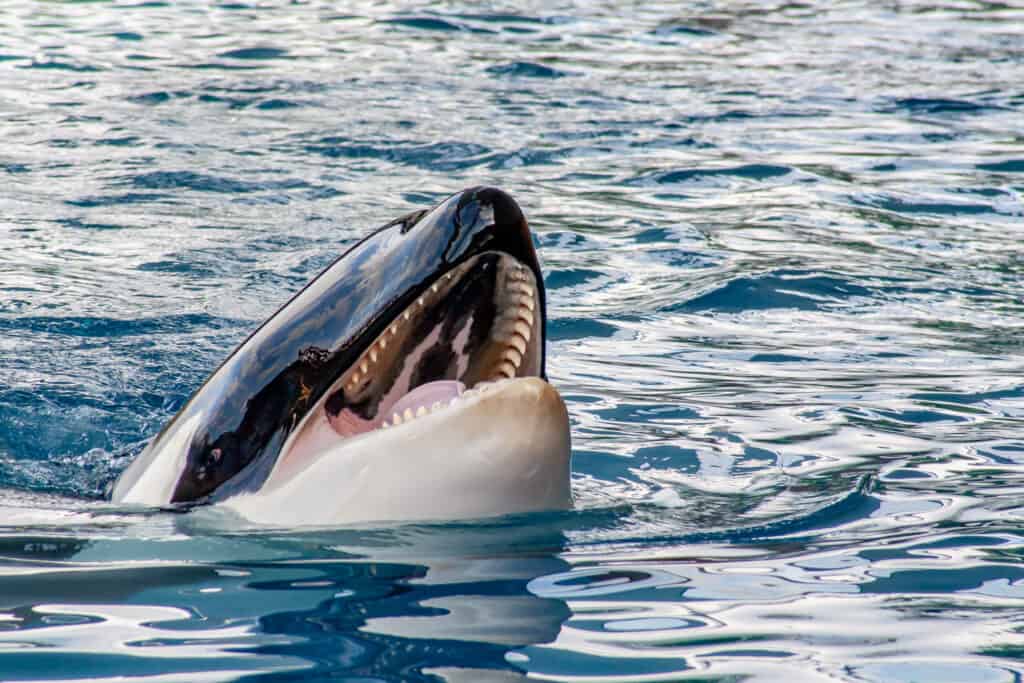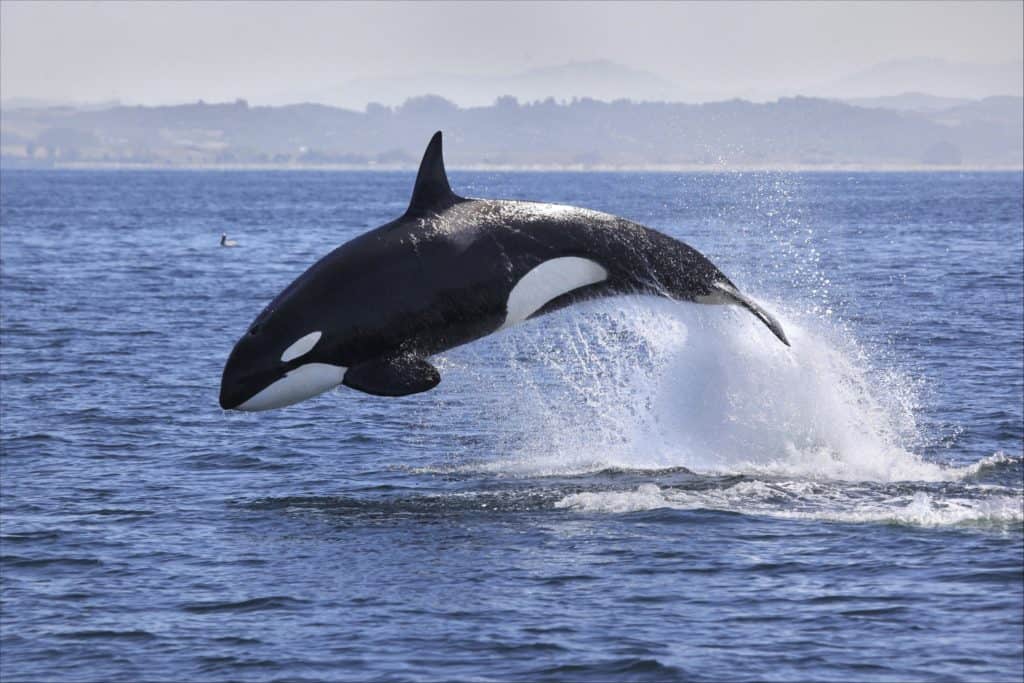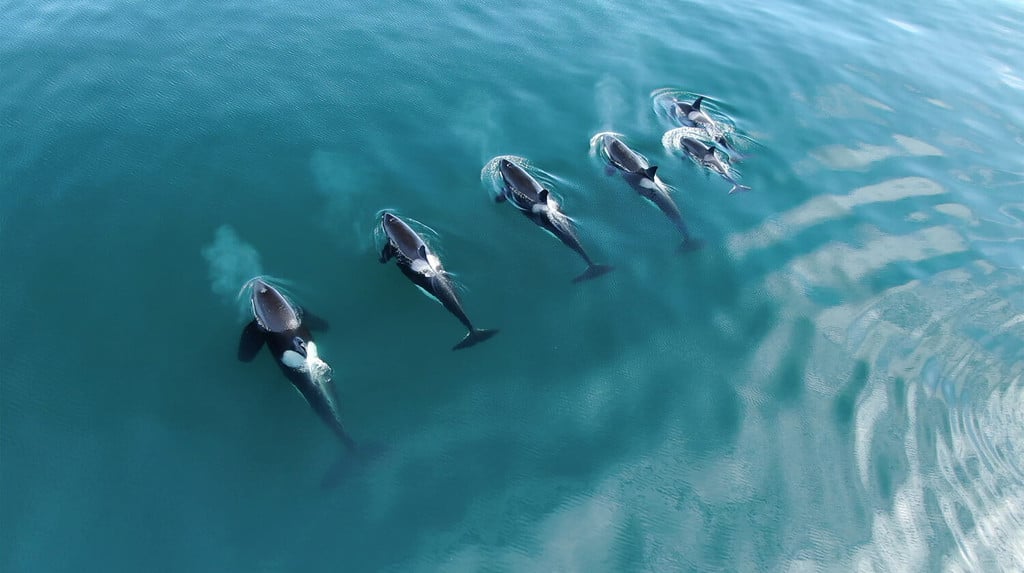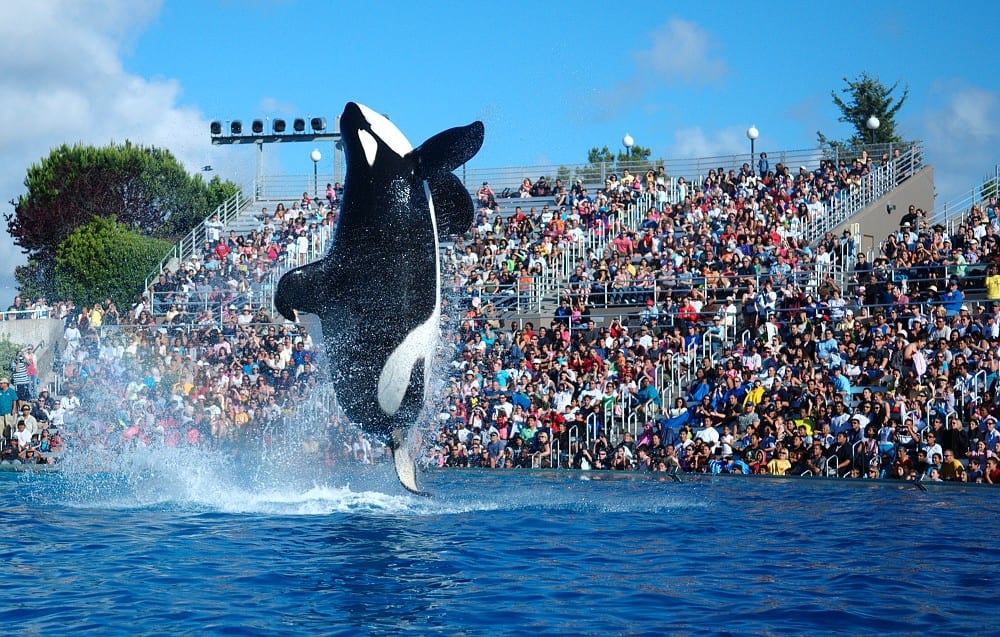Orcas are one of the ocean’s top predators and can conquer the greatest aquatic beasts known to man. While orcas are called killer whales, their behavior in the wild does not reflect a murderous nature, at least not toward humans. Rather, orcas are beautiful, calm creatures that rarely show aggression or violence toward people. Discover why orcas are referred to as killer whales despite their docile nature and learn about their group hunting methods.

Orcas are not dangerous to human life and should not be kept in captivity.
©Tory Kallman/Shutterstock.com
What are Orcas?
Orcas, also known as killer whales, are marine mammals that swim throughout Earth’s oceans. Although referred to as killer whales, orcas are a type of dolphin. One impressive fact about the orca is that it is the largest species belonging to the dolphin family and one of the strongest and most fearsome. Orcas are carnivores, meaning they only eat the meat and flesh of other animals.
Orcas may live between 50 and 80 years in the wild but can experience a significantly shorter lifespan while in captivity. In fact, many amusement parks across the country keep orcas in captivity today. Captivity is one of the major threats that harm orcas and cause them to become violent toward humans.

While their name causes people to believe orcas are whales, orcas actually belong to the dolphin family.
©Guillermo El Oso/Shutterstock.com
Orca Appearance
Orcas may measure between 23 and 32 feet in length, as they are massive animals! In addition, orcas may weigh up to six tons, which translates to around 12,000 pounds. Most people recognize orcas from their unique coloration, which appears distinctly black and white. One special feature of the orca is its sharp and powerful teeth, which may exceed 4 inches in length but usually measure around 3 inches long.
Why are Orcas Called Killer Whales?
The original term for the orca was “ballena asesina,” meaning “whale killer.” While orcas are considered dolphins, they are related to whales, too. However, the name “killer whale” does not describe orcas’ classification but their behavior. During ancient times, sailors watched orcas and their feeding behaviors. These sailors noticed how orcas attacked and killed whale species much larger than themselves. Thus, sailors gave them the name “whale killer,” which eventually transformed into “killer whale.”
In addition, the scientific name of the orca is Orcinus orca. Orcinus is Latin for “of the kingdom of the dead.” Meanwhile, orca means a type of whale. Thus, the scientific name of these beasts mimics their predatory behavior, too. These “whales” are fierce apex predators with many types of prey, and their hunting often results in death.

“Ballena asesina” is Spanish for “killer whale.”
©Tory Kallman/Shutterstock.com
Orca Hunting and Feeding
Orcas are ferocious predators, able to take down the largest of creatures, such as the fearsome great white shark. In fact, orcas do not have any natural predators, making them apex predators. When hunting for food, orcas use echolocation to detect prey. They make underwater noises, such as clicks, and these noises bounce off objects and travel back to the orcas as echoes. Through this process, orcas can determine where prey resides, based on how the echoes travel back to them.
In addition, orcas travel together when hunting. A group of orcas is called a pod, and a pod is typically comprised of no more than 40 members. Furthermore, two main types of pods exist: transient pods and resident pods. Transient pods are usually smaller than resident pods, and members feed on marine mammals. On the other hand, resident pods tend to be bigger, and members prefer to eat fish.
Orcas attack prey in various ways. Members of a pod often encircle prey, trapping a school of fish, for example. Orcas also strike with their tails, which stuns the prey. While prey is disoriented, the orcas can go in for the kill. In addition, orcas that hunt marine mammals, such as seals, work together to knock their prey off fragments of ice. For example, groups of orcas create waves that wipe the trapped seal into the water. This leaves the seal defenseless against the killer whales.
The orca’s status as an apex predator combined with its many types of prey is what makes this creature so formidable. While the term “killer whale” may have arisen in antiquity, the name rings true today. Orcas can overpower massive, threatening creatures that no other animal would dare challenge. Overall, orcas have some serious predatory instincts, making them one of the most powerful animals in the deep blue sea.

Transient pods primarily feed on marine mammals, while resident pods mainly eat fish.
©Willyam Bradberry/Shutterstock.com
What do Orcas Eat?
An orca’s diet depends on the members of their pod and the types of pods in which they reside. For instance, transient pods typically feed on marine mammals, including seals, sea lions, dolphins, and whales. On the other hand, resident pods are likely to feed on smaller animals, such as fish. Some examples of prey that comprise the diet of resident pods include sharks, stingrays, birds, octopuses, and fish.
Do Orcas Kill Humans?
Despite being called killer whales, orcas have not killed a human in the wild. In fact, orcas seem to get along well with humans, even when they have had the opportunity to attack them. In captivity, though, stressed orcas can grow violent, and orca attacks on humans in captivity have occurred.
For instance, an orca killed a SeaWorld trainer named Dawn Brancheau in 2010. A male orca named Tilikum pulled Brancheau underwater, shaking her violently, resulting in several injuries and Brancheau’s death.
Following the trainer’s passing, SeaWorld did not allow trainers to swim alongside orcas in their facilities. In addition, a conservationist movement arose after the incident, in which many people argued that orcas should be released from captivity. Now, SeaWorld has promised to stop breeding orcas, and the park no longer houses new orcas. Rather, SeaWorld works to rehabilitate the orcas they already own. SeaWorld may likely have no orcas left in captivity in the coming years.

Parks like SeaWorld once trained killer whales to perform in shows for live audiences.
©Yathin S Krishnappa, CC BY-SA 3.0, via Wikimedia Commons – License
Where do Orcas Live?
Orcas have a patchy distribution throughout the world’s many oceans. While killer whales swim in all oceans on Earth, certain areas claim a greater orca population than others. For instance, orcas prefer cold waters, so their largest populations reside near places like Alaska and Antarctica. However, they may also reside in subtropical or tropical waters near locations like Mexico or Western Africa. In the United States, killer whales are most abundant along the West Coast, close to states like Washington, California, or Oregon.

Most orcas are found in cold waters near Arctic regions across the globe.
©Jaime Ramos – Public Domain by National Science Foundation
Orca Characteristics: A Summary
| Characteristics | Orcas |
|---|---|
| Size | 23 to 32 feet in length |
| Weight | Up to six tons |
| Coloration | Black and white |
| Location | Patchy distribution in all Earth’s oceans |
| Habitat | Cold, subtropical, or tropical waters |
| Prey | Sharks, stingrays, cephalopods, fish, seals, sea lions, dolphins, whales, birds, and more |
| Predators | None |
| Scientific Name | Orcinus orca |
| Other Common Names | Killer whale |
| Lifespan | 50 to 80 years (in the wild) |
| Threats | Captivity, bycatch from fishing, habitat loss, climate change, and humans |
| Dangerous to Humans? | No (in the wild) |
The photo featured at the top of this post is © slowmotiongli/Shutterstock.com
Thank you for reading! Have some feedback for us? Contact the AZ Animals editorial team.







